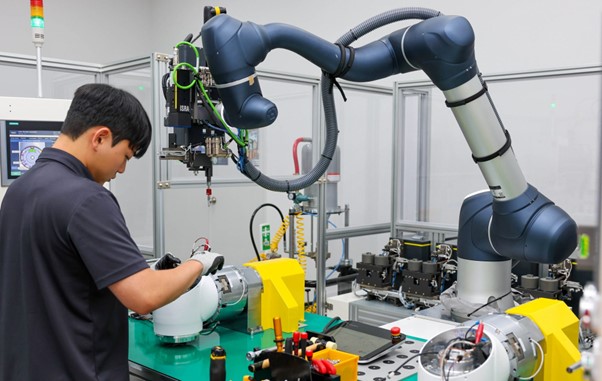Doosan Robotics strengthens its business competitiveness with innovative DNA...continues growth momentum
2023. 12. 07

Doosan Robotics will continue its growth by strengthening its business competitiveness in various fields, including R&D, production, and solutions, based on its innovative DNA.
On the 7th, Doosan Robotics announced that it has unveiled a large number of new collaborative robot solutions at its production plant in Suwon, Gyeonggi-do. The new solutions unveiled this time include ▲ group catering solution, ▲ laparoscopic surgery assistance solution, ▲ airport baggage handling solution, ▲ laser welding solutions, and ▲ bin-picking solution.
The group catering solution was first introduced in Korea last November in the school cafeteria of a middle school in Seoul, where four collaborative robots perform large-scale cooking work such as making soups and stews, stir-frying, and deep-frying. The introduction of the solution is expected to improve work efficiency and worker safety, as repetitive movements and oil fumes generated during cooking can cause musculoskeletal disorders and burns in workers, and may also have a negative impact on their respiratory system.
The laparoscopic surgery assistance solution requires precise movements as the endoscopic camera is mounted on the collaborative robot and moves inside the body. The solution can withstand a load of 3 kg and can be remotely controlled using a joystick. It is expected to be highly utilized as the robot takes over the strenuous task of holding the endoscope camera for a long time, which previously required two to three doctors.
The airport baggage handling solution was developed in collaboration with Danish company Cobot Lift and is used to move baggage at airports. Doosan Robotics’ H-series collaborative robots, capable of lifting objects weighing up to 25 kg, can lift up to 70 kg when combined with Cobot Lift's technology. Doosan Robotics recently completed a Proof of Concept (PoC) at Schiphol Airport in the Netherlands.
The laser welding solution offers faster welding speeds than before and produces smoother surfaces that require no additional work. It is expected to be in high demand in advanced industries such as aerospace, automotive, and medical equipment due to its high degree of completion of work. In particular, it can be used with a variety of materials and thicknesses without damaging the bonding material due to heat.
The bin-picking solution is that picks up the desired parts from a mix of various parts piled up in a box and moves them to a designated location in sequence. With 3D vision technology built in, the collaborative robot can accurately pick up parts itself, pinpointing not only the position and shape of the parts, but also their orientation and degree of inclination.
Along with this, Doosan Robotics showcased various collaborative robot solutions, including coffee, frying (chicken), palletizing, and educational kits on the spot.
Doosan Robotics also decided to build an automated cell facility on the second floor of its Suwon factory to increase the efficiency and expand the scale of production. The automated cell is a facility where collaborative robots and humans work together to build collaborative robots. Doosan Robotics' collaborative robots are made up of six axes, each of which is called a module. One module requires about 70 bolt fastening operations. After a human prepares the preliminary work, the collaborative robot fastens the bolts.
Currently, it takes about 60 minutes to produce one collaborative robot module. With the introduction of the automated cell, production time is decreased to about 37 minutes, improving efficiency by 38%. Doosan Robotics plans to build a total of nine automated cell facilities next year, increasing the production capacity of its Suwon plant to 4,000 units, about doubling from the current 2,200 units.
In the future, it plans to incorporate autonomous mobile robots (AMRs) into the automated cells to promote logistics automation. Through this, the company plans to automate the transfer of parts from the material warehouse, transporting and loading modules after assembly to the warehouse, and moving them to the module combining process, with the aim of improving efficiency.
In addition, Doosan Robotics has decided to accelerate software innovation. In October, Doosan Robotics launched Dart Suite, a software-centric ecosystem designed to provide a smartphone-like user experience, enabling both developers and users to easily use collaborative robots.
Doosan Robotics has decided to incorporate artificial intelligence into its Dart Suite to improve user convenience. Incorporating AI will allow for faster implementation of collaborative robot features while minimizing user intervention. Ultimately, it will also allow the development of next-generation solutions that learn and make decisions on their own. Doosan Robotics is actually developing a GPT-based collaborative robot solution with Microsoft. Recently, it won the CES 2024 Innovation Award (Honoree) for its AI-powered recycling sorting solution, "Oscar the Sorter."
Junghoon Ryu, CEO of Doosan Robotics, said, "Doosan Robotics' product development and continuous growth have been possible by the innovative DNA and passion in the hearts of all our executives and employees," and added, "Doosan Robotics aims to dramatically increase productivity and efficiency compared to the past while humans and robots work safely together in the same place." They also added, "We will expand our business domain through diversification of collaborative robot solutions and software innovation while developing into a company that further enriches human lives."
Doosan Robotics is also striving to strengthen its overseas sales and marketing. Last year, it established a North American subsidiary in Plano, Texas, and plans to establish a European subsidiary in Germany in 2024. The company is also considering expanding into new regions such as Central and South America, and Southeast Asia, and plans to increase its overseas sales channels from the current 100 to 219 by 2026.


